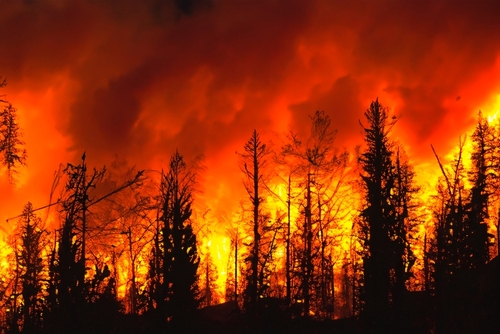The Real Story of Wildfire Smoke and Why It Matters for Schools and Hospitals
Wildfires may burn in specific regions, but their smoke is a global problem. It drifts across state lines, national borders, and even oceans—turning a localized crisis into a worldwide public health issue. Schools and hospitals, where vulnerable populations spend extended periods, are particularly susceptible to the long-lasting effects of wildfire smoke.

The Hidden Danger of Wildfire Smoke
Wildfire smoke is far more than a short-term nuisance; it’s a toxic mixture of super fine particles (primarily <0.3 microns, which are 1/10th the size of largest PM2.5), volatile organic compounds (VOCs), and other harmful chemicals. These microscopic pollutants infiltrate buildings, linger indoors, and pose significant health risks—especially for children, patients, and healthcare workers.
Not All PM2.5 Are the Same
The term particulate matter (PM2.5) refers to particles that are 2.5 microns or smaller in diameter—often described in popular media as 30 times smaller than the diameter of a human hair (~70 microns). Many types of air polluting particles are lumped in with PM2.5, including wildfire smoke. However, wildfire smoke particles are mainly 0.1-0.3 microns in diameter, which is more than 300 times smaller than a strand of hair. They are so small that they are invisible to the naked eye, even PM sensors and particle counting instruments that industry and regulators often rely on.
Meanwhile, MERV (Minimum Efficiency Reporting Value)-rated air filters are not tested for particles of this size or type. Such a rating is determined by testing a filter’s ability to capture salt particles (sodium chloride or potassium chloride, for example) larger than 0.3 microns. So, neither the particle size nor chemical makeup of the test particles is representative of wildfire smoke. Importantly, it turns out that these smoke particles can greatly reduce filter effectiveness, including that of MERV 13.
The Health Impacts of Wildfire Smoke Exposure
Recent research highlights alarming links between wildfire smoke exposure and serious health effects. Stanford researchers suggest that smoke is 10x the toxicity of other air pollutants. Among the long list of concerns are the following:
- Respiratory and cardiovascular diseases: Super fine particles from wildfire smoke can exacerbate asthma, chronic obstructive pulmonary disease (COPD), and heart conditions.
- Cognitive decline and dementia risks: Studies indicate that long-term exposure to wildfire smoke may significantly increase the risks of cognitive impairment and dementia, more so than other air pollutants.
- Depression and mental health issues: Studies suggest that exposure to wildfire smoke is associated with higher rates of depression and mental illnesses.
- Premature births: Pregnant individuals exposed to wildfire smoke have a greater likelihood of preterm births and low birth weights that could result in long-term health risks to infants.
- Overall mortality risks: Yale research confirms that prolonged exposure to wildfire smoke correlates with increased mortality rates, reinforcing the urgency of better air quality management.
Key Facilities Focus: Schools and Hospitals Face Unique Air Quality Challenges
Indoor air quality (IAQ) in schools is already a concern due to aging ventilation systems and high occupancy rates. A recent survey showed that over 80% of teachers are worried about air quality, particularly for disease transmission in schools. The problems are even more complicated during wildfire smoke events. Without effective and safe air cleaning, students and teachers could be left breathing harmful particles throughout the school day.
For hospitals and medical facilities, the risks are even more severe. Patients with respiratory conditions, weakened immune systems, and chronic illnesses are highly susceptible to airborne pollutants. Smoke infiltration can compromise environments like hospital operating rooms that depend on high rates of outdoor ventilation and disrupt patient recovery. Additionally, healthcare workers exposed to poor air quality over long shifts may experience respiratory distress, fatigue, and long-term health consequences. All of these tend to coincide with increased hospital admissions due to smoke-related health complications.
In both environments, adopting traditional ventilation strategies—bringing in “fresh” outdoor air—would mean drawing in pollutants, worsening IAQ instead of improving it. Therefore, it is best to reduce or shut down ventilation, seal vents and windows, close doors, and circulate and filter indoor air.
A Multi-Layered Solution for Protecting Schools and Hospitals
To combat the dangers of wildfire smoke, a comprehensive approach is necessary:
- Careful filter selection: Schools and hospitals need to implement filtration solutions capable of capturing super fine smoke particles, beyond relying on MERV ratings when making filter purchasing decisions.
- Real-time air quality monitoring: Continuous IAQ tracking could be used to help administrators track trends and decide when to adjust ventilation or increase filtration operations.
- Emergency preparedness plans: As emphasized in ASHRAE Guideline 44-2024, “Protecting Building Occupants from Smoke During Wildfire and Prescribed Burn Events,” having clear protocols in preparation for wildfire smoke events would be highly beneficial.
- Advanced air purification: Facilities should invest in localized high-efficiency air cleaning systems to better protect sensitive populations.
The Time to Act Is Now
Wildfire smoke is not just a problem for the western U.S. or regions near active fires—it affects communities everywhere. Schools and hospitals must be proactive in protecting everyone who is within the facility from the invisible, far-reaching consequences of smoke pollution. This is also an opportunity to maximize community investment. Preparing in advance and selecting effective air quality solutions are essential for ensuring the health of students, patients, and staff.
Sissi Liu is CEO and co-founder of Metalmark Innovations.
The post The Real Story of Wildfire Smoke and Why It Matters for Schools and Hospitals appeared first on Facilities Management Advisor.

